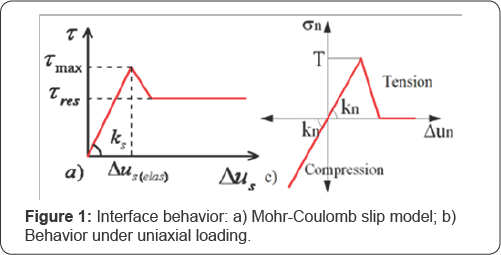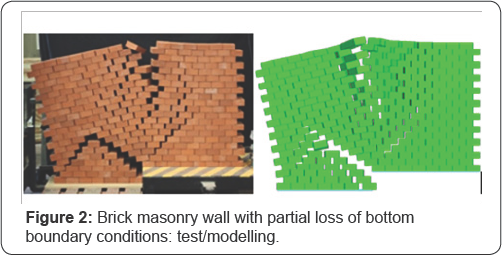Using DEM to Simulate the Behavior of Masonry and Rammed Earth Structures- Juniper Publishers
Juniper Publishers- Journal of Civil Engineering
Abstract
The present opinion paper gauges the efficiency of
Discrete Element Method (DEM) to reproduce the behaviour of masonry
structures and rammed earth walls submitted to in plane or membrane
loading, and out of plane or bending loading cases. The efficiency of
the DEM is estimated for all nonlinear behaviours, from cracks
appearance and associated stress re distributions, cracks propagation,
until the failure mechanism related to the ultimate load.
Keywords: Masonry ; Rammed earth ; Discrete element method
Introduction
Discrete element method (DEM) has its origin in the
early 1970s. Initially used to simulate progressive rock movement using
rigid block assemblies in two dimensions [1,2]. This technique was later extended to predict the mechanical behavior of masonry [3-5] and rammed earth structures [6].
In DEM, the heterogeneous nature of the masonry or rammed earth is
taken into account explicitly, and the discontinuity of interfaces
between blocks or earthen layers can be described. Masonry blocks or
rammed earth blocks are represented as an assembly of rigid or
deformable blocks which may take any arbitrary geometry. Rigid blocks do
not change their geometry as a result of any applied loading.
Deformable blocks are internally discretised into finite difference
triangular zones. These zones are continuum elements as they occur in
the finite element method (FEM). However, unlike FEM, in the distinct
element method a compatible finite element mesh between the blocks and
the joints is not required. Mortar joints or earthen layers are
represented as zero thickness interfaces between the blocks.
Representation of the contact between blocks is not based on joint
elements, as for continuum finite element models. Instead, the contact
is represented by a set of point contacts with no attempt to obtain a
continuous stress distribution through the contact surface. The
assignment of contacts allows the interface constitutive relations to be
formulated in terms of the stresses and relative displacements across
the joint. As with FEM, the unknowns are the nodal displacements and
rotations of the blocks. However, unlike FEM, the unknowns in DEM are
solved explicitly by differential equations from the known displacement
while Newton's second law of motion gives the motion of the blocks
resulting from known forces acting on them. So, large displacements and
rotations of the blocks are allowed with the sequential contact
detection and update of tasks automatically. This differs from FEM where
the method is not readily capable of updating the contact size or
creating new contacts. This method is also applicable for quasi-static
problems using artificial viscous damping controlled by an adaptive
algorithm. In view of the diversity and complexity of non-linear
behavior observed across masonry and rammed earth structures, the
validation of discrete modeling remains a crucial task.
Application of DEM

The 3DEC code (Itasca, 2011) can be used for DEM. The
masonry or RE wall is modeled as an assemblage of discrete blocks
(earthen layers), and the interfaces between earthen layers are modeled
by introducing an interface law. The interfaces between blocks or
earthen layers can be modeled by an interface law between the blocks
following the Mohr-Coulomb interface model with a tension cut-off [6].
This interface constitutive model considers both shear and tensile
failure, and interface dilation is included. In the elastic range, the
behavior is governed by normal and shear stiffness of the interface (Figure 1).

For masonry structures, this simple interface behavior has been conducted in [5]
to gauge the efficiency of DEM to reproduce nonlinear behaviour of
masonry walls submitted to in plane or out of plane loads. The numerical
simulations provide good agreement with experimental results (Figure 2).
In particular, the conducted simulations allow us to qualify the
bearing capacity of the structures as well as the associated failure
modes. The nonlinear behaviours observed in the experimental
load-deflection curves are globally correctly reproduced from the
initiation up to the final failure. This, traduce that crack appearance
and propagation, are correctly reproduced. Stress re distributions
inherent to cracks, are also correctly managed, which permits to catch
crack propagation and the final failure mechanism traducing the correct
estimation of the bearing capacity as well as the characterization of
the collapse mode of the structure.
For rammed earth structures, the study conducted by [6]
showed that the DEM with the Mohr-Coulomb model reproduced the failure
mode better than the FEM did (with Mazars' damage model) as shown in a
previous study Bui et al. [5].
The results confirmed that, in the case of vertical loading, interfaces
did not have an important effect on the behavior of RE walls. In the
case of diagonal loading (which can simulate a seismic case), interfaces
should be considered in order to produce better results relative to the
ultimate load and failure modes (Figure 3).

Conclusion
In the conclusion, the DEM is relevant for the
simulation of failure of masonry and rammed earth structures, where good
quality results have been achieved. The discrete element method allows
to simulate rupture phenomenon and thus to manage discontinuities in an
elegant and robust way.
For More Open Access Journals Please Click on: Juniper Publishers
Fore More Articles Please Visit: Civil Engineering Research Journal
Fore More Articles Please Visit: Civil Engineering Research Journal


Comments
Post a Comment